
|

|
Viking Age Arms and Armor
Viking Mail
 |
Much of the text presented on this page is out-of-date. Until we find time to make the needed updates to this page, we strongly encourage readers to look at this topic as it is presented in our new book, Men of Terror, available now from your favorite book seller. |
|
|
Mail is a protective iron fabric made up of thousands of interlocking iron rings. In the Viking era, mail was always made with a 4-in-1 pattern, in which each ring passes through its four nearest neighbors. (The photo to the left shows a modern reproduction.) |
During the Viking age, mail usually was worn in the form of a mail shirt (brynja), like the reproduction shown to the right. Typically, the garment was T-shaped, with short sleeves (half to three-quarters length) and thigh length. (Anything longer would make it difficult to ride a horse, although in later periods, slits in the mail placed front and rear between the legs allowed riders to wear longer mail shirts.) The reproduction mail shirt shown in the photo weighs about 12kg (26lbs). The weight is not particularly burdensome, since a lot of the weight is taken up on the hips by the belt. Regardless, the stories say that sometimes raiders left their mail shirts on board ship when they went raiding, so they wouldn't be weighted down. In chapter 82 of Haralds saga Sigurđarsonar, the author relates that on the day of the battle at Stamford Bridge, it was a day with hot sunshine, and the Norwegians left their mail shirts behind, on board ship. |
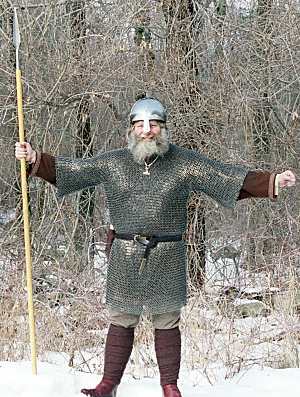 |
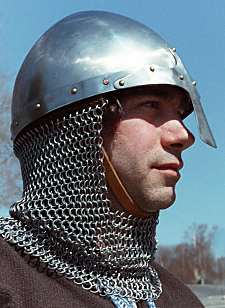 |
The 12kg of iron in a mail shirt represented a treasure in the Viking age. Few people could have afforded that much iron. Thus, mail shirts must have been very rare. Anyone who could have afforded one would certainly have wanted one, but probably few people could afford one. Someone who couldn't afford a mail shirt might have used smaller pieces of mail to protect the more vulnerable parts of the body. The reproduction helmet shown to the left has a mail curtain that protects the most vulnerable part of the neck from cuts. It provides significant protection while using only a fraction of the iron of a full mail shirt. |
|
In order to make mail, a smith needed a supply of iron wire. Most likely, he fabricated the wire by drawing an iron bar repeatedly through smaller and smaller openings in a drawplate. A 10th century drawplate from Norway is shown to the right, which is about 15cm long (6in). |
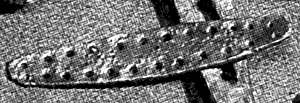 |
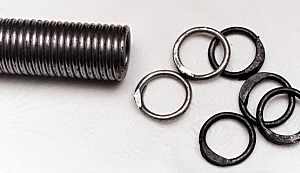 |
The wire was wound around a wooden form to create a coil of iron wire. The coil was split down its length to create a number of open iron rings. (In the photo to the left, the brighter rings have just been cut from the coil, while the darker rings have been annealed and are ready for the next step.) One by one, each ring was passed through neighboring rings to form the fabric of the shirt, then closed and sealed shut with a rivet. This process was repeated again and again, thousands and thousands of times to make up the fabric of the shirt. The reproduction mail shown in the photo above is made from about 30,000 rings. |
|
Some samples of mail from the Viking age are made up entirely from riveted rings, like the reproduction mail shown above. In a few examples of Viking-age mail, the solid rings appear to have been welded shut. Most samples, however, have alternating riveted and solid rings, such as the 10th century mail from Gjermundbu, shown to the right. |
|
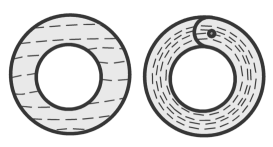 |
The orientation of the slag intrusions in the rings (left) suggests that the solid rings were punched out of sheet metal, while the riveted rings were made from drawn wire. The square cross section of the solid rings provides further evidence that the rings were punched. |
Most samples of Viking age mail use round rivets, such as the Gjermundbu mail shown above. The smooth, unfaceted shape of the Gjermundbu rivet heads suggests that a setting tool was used to set the rivets.
|
Regardless of how it was accomplished, the rings of mail were made solid. Links which were simply bent into shape and butted together without a means to hold them shut were not strong enough to stand up to the rigors of combat. The photo shows historical butted mail from Asia. |
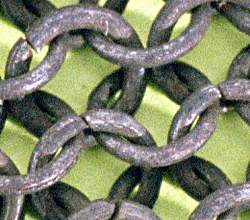 |
The rings were linked into rows then joined into panels of manageable size and weight, before being linked together to make the final garment. As the panels were linked, alterations to the 4-in-1 pattern were made to shape the fabric to the contours of the body and to provide freedom of motion in places such as under the arm. Rings were dropped or added to rows as needed to shape the finished fabric.
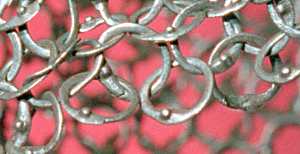 |
During the Viking age, the diameter and gauge of the wire rings varied considerably. The photo to the left shows the sleeve of a 13th century mail shirt, which uses finer wire and smaller diameter rings than either the modern reproduction or the Gjermundbu mail shown above. The diameter of the rings in the Gjermundbu shirt average 8mm (0.3 in), and the wire diameter averages 1.2 mm (0.05 in, about 16 gauge). |
Another 13th century mail shirt is shown to the right having wire and ring diameters typical for the Viking age. Wire diameter ranged from 0.8 to 2.7 mm (0.03 to 0.1 in) and ring diameter ranged from 5 to 12 mm (0.2 to 0.5 in) in Viking-age mail.
|
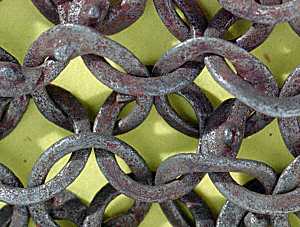 |
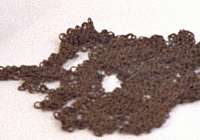 |
Little mail survives from the Viking era. Underground or underwater, the thin rings corrode very quickly. Most mail from the period survives as a rusty pile of junk. The mail shown to the left was found in Sveinsströnd in Iceland and is better preserved than most. Originally thought to be from the 10th century, it has more recently been dated from the 13th century or later. The one more or less complete Viking age mail shirt (from Gjermundbu) was in many pieces when found. Numerous sections were corroded into a solid mass. Some of the rings survive only as hollow corroded shells. But some sections of the shirt (right) survive in excellent condition. |
|
In the sagas, mail is usually referred to as brynja, meaning a mail-shirt. Occasionally, other forms of mail are mentioned. In Harđar saga (ch. 36), Hörđur repaid Kjartan for some treachery, striking at Kjartan with a sword and splitting him and his mail down to the waist. Kjartan's mail is called tvíföld brynja, which has the sense of a double layer of mail. Perhaps Kjartan was wearing a mail made with a pattern other than 4-in-1. One possibility is 8-in-2, in which every ring is doubled up, so a pair of rings is passed through by 4 additional pairs of rings. The archaeological record, although sparse, does not support the use of this kind of mail in Viking lands. A historical example from Asia is shown in the photo. |
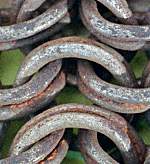 |
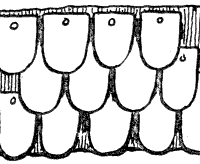 |
Occasionally, the sagas refer to spangabrynja, which has the sense of "plate mail". In Grćnlendinga ţáttur (ch. 5), Símon was given some old spangabrynja as compensation for the killing of a kinsman. Whatever the armor might have been, the saga says that Símon was insulted by the offer, and he threw the spangabrynja to the ground as useless junk, resulting in another fight and more killings. One wonders if spangabrynja might have been scale armor or possibly lamellar armor. These kinds of armor were in use in other lands during the Viking age, but not in Norse lands. Perhaps a roving Viking brought some home with him. Scale armor was made by attaching many small overlapping plates of metal or horn to a flexible backing made of leather or fabric (left). |
It's important to note that mail does not provide a complete defense; mail is only a secondary defense. If one were to draw the edge of a sword across the arm of an combatant wearing a mail shirt, the sword wouldn't bite; the mail would protect against a cut. However, if one were to take that same sword and strike a powerful blow against the arm or shoulder of the combatant, the mail would not prevent the skin from being bruised, or the bones from being broken. The mail does little to absorb or dissipate the force of a blow, and the force passes right through the mail.
Both before and after the Viking era, fighting men wore padded garments under their mail to help absorb the force of a blow (right). Typically, these garments consisted of two layers of wool or leather stuffed with fleece or animal hair, then sewn together. However, there is no archaeological evidence that such garments were worn during the Viking era, nor any mention of them in the stories. One hopes that the Norsemen were aware of and used such garments. They make a enormous difference in comfort and safety in simulated combat. One assumes that in real combat, they could make the difference between a disabling injury and a minor one. Although the mail protects from a cut, the stories say that mail could be punctured by weapons. In chapter 53 of Egils saga, Ţórólfur, using two hands, thrust his spear through Earl Hring's mail shirt (and through the earl as well). In chapter 37 of Laxdćla saga, Eldgrímr tried to buy horses from Ţorleikr, who refused to sell. When Eldgrímr tried to take the horses, Ţorleik's kinsman Hrútr saw what was going on and intercepted Eldgrímr. After a brief discussion, Eldgrímr turned to ride away with the horses. Hrútr raised his bryntröll (meaning mail troll, an unknown pole weapon) and drove it between the shoulder blades of Eldgrímr. The bryntröll split the mail shirt that Eldgrímr wore, and the head of the bryntröll came out through Eldgrím's chest, killing him. Hrútr was over eighty years old at the time. |
 |
 |
Forensic evidence confirms that mail could be punctured. The thigh bone (femur) shown to the left is from the skeletal remains of a man about 20 years old who died from combat injuries in the 11th century. The bone shows clear marks of the impact of ring mail against the bone, suggesting his upper leg was hit with a sword blow so powerful as to force the rings of his mail shirt through the muscles of his leg into contact with the bone. People who have done test cuttings using modern reproductions of sword and mail doubt this interpretation. However, I have not heard an alternate interpretation that explains the forensic evidence. |
|
There are examples in the sagas where men thrust weapons up under a mail shirt, causing wounds. After being wounded in the leg during the battle of Stiklastađir in the year 1030, King Ólafr leaned against a boulder. Ţórir hundr thrust his spear up under the king's mail, piercing him through the belly. Kálfr struck a blow to the king's neck. The king fell dead. |
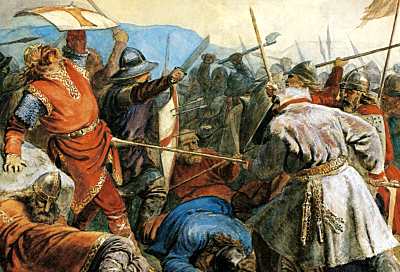 |
In chapter 2 of Hallfređar saga, it is said that after a long night of drinking, Sóti and his men went up to the loft to retire for the night. Óttar and Ávaldi broke in to the house to fight. Óttar thrust his sword up under Sóti's mail shirt, into his gut, killing him. An interesting aspect of this episode is that Sóti was wearing mail while drinking at night in his farm house. One wonders why he felt a need to wear mail in this situation.
There are a number of interesting examples in the sagas in which men chose not to use mail, even though it was available to them, such as in chapter 19 of Grettis saga. While preparing to defend the household from twelve vikings, Grettir grabbed a spear, sword, and helmet, but left behind a mail shirt.
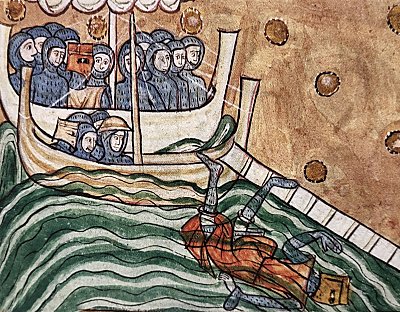 |
Occasionally, the sagas tell of a sea battle in which fighters jump overboard during the fight and sink from the weight of their battle gear (for example, Ólafs saga Tryggvasonar ch.107). When the king jumped overboard, he sank from sight, shown in a manuscript illumination to the left. The saga adds that some believe he was able to remove his mail shirt underwater and swim undetected to a nearby ship (ch.112). |
 |
We decided to do some testing to see if it was possible to swim while wearing Viking clothing and a mail shirt. Some of us were successful, and others sank to the bottom after only a stroke or two. Those who were successful swimming had no problem jumping in to the water and swimming up to the surface while wearing mail. These tests suggest that it wasn't just the weight of the mail that caused men to sink below the surface after jumping in the water while wearing mail. |
 |
|
|
<< Previous article |
Back to Arms and Armor |
Next article >> |
|
©1999-2025 William R. Short |